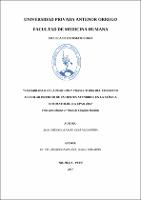Mostrar el registro sencillo del ítem
Variabilidad en la posición y trayectoria del conducto alveolar inferior de pacientes atendidos en la Clínica Estomatológica UPAO 2016
| dc.contributor.advisor | Vasquez Zavaleta, Jorge Eduardo | |
| dc.contributor.author | Ordinola Arias, Gina Alexandra | |
| dc.creator | Ordinola Arias, Gina Alexandra | |
| dc.date.accessioned | 2017-11-28T15:53:06Z | |
| dc.date.available | 2017-11-28T15:53:06Z | |
| dc.date.issued | 2017 | |
| dc.identifier.uri | https://hdl.handle.net/20.500.12759/3364 | |
| dc.description.abstract | El presente estudio tuvo como objetivo principal determinar la variabilidad en la posición y trayectoria del conducto alveolar inferior de pacientes atendidos en la Clínica Estomatológica UPAO 2016. El estudio fue retrospectivo, transversal, descriptivo, observacional. La muestra fue de 32 tomografías en las que se evaluaron las 64 hemimandíbulas de pacientes mayores de edad realizando cortes a nivel de 2da premolar, 1era molar y 2da molar. Se calcularon promedios y varianzas y se utilizaron las pruebas estadísticas F de Fisher y t de student donde se consideró un nivel de significancia de 5%. Los resultados mostraron que no existe diferencia significativa en los valores obtenidos en cuanto a cuadrante, sin embargo si la hay al comparar los resultados en cuanto a sexo. Se concluyó en que el conducto alveolar inferior muestra mayor proximidad a la tabla vestibular a nivel de la 2da premolar y mayor proximidad a la tabla lingual, a nivel de la 2da molar y la distancia hacia el reborde basal es mayor a nivel de 2da premolar y 2da molar y menor a nivel de 1era molar. | es_PE |
| dc.description.abstract | The present study had as main objective to determine the variability in the position and trajectory of the inferior alveolar duct of patients attended in The Stomatologic Clinic UPAO 2016. The study was retrospective, transverse, descriptive, observational. The sample consisted of 32 tomographies in which the 64 hemimandibles of elderly patients were evaluated, performing cuts at the level of 2nd premolar, 1st molar and 2nd molar. Averages and variances were calculated and Fisher's F and Student's T tests were used where a significance level of 5% was considered. The results showed that there is no significant difference in the values obtained in quadrant, however if there is one when comparing the results in terms of sex. It was concluded that the inferior alveolar duct shows greater proximity to the vestibular table at the level of the 2nd premolar and greater proximity to the lingual table at the level of the 2nd molar and the distance towards the basal flange is greater at the level of 2nd premolar and 2nd molar and lower at the 1st molar level. | en_US |
| dc.description.uri | Tesis | es_PE |
| dc.format | application/pdf | es_PE |
| dc.language.iso | spa | es_PE |
| dc.publisher | Universidad Privada Antenor Orrego - UPAO | es_PE |
| dc.relation.ispartofseries | T_ESTO_483 | |
| dc.rights | info:eu-repo/semantics/openAccess | es_PE |
| dc.source | Universidad Privada Antenor Orrego | es_PE |
| dc.source | Repositorio Institucional - UPAO | es_PE |
| dc.subject | Conducto alveolar inferior | es_PE |
| dc.subject | Trayectoria | es_PE |
| dc.title | Variabilidad en la posición y trayectoria del conducto alveolar inferior de pacientes atendidos en la Clínica Estomatológica UPAO 2016 | es_PE |
| dc.type | info:eu-repo/semantics/bachelorThesis | es_PE |
| thesis.degree.level | Título Profesional | es_PE |
| thesis.degree.grantor | Universidad Privada Antenor Orrego. Facultad de Medicina Humana | es_PE |
| thesis.degree.name | Cirujano Dentista | es_PE |
| thesis.degree.discipline | Estomatología | es_PE |
Ficheros en el ítem
Este ítem aparece en la(s) siguiente(s) colección(es)
-
Estomatología [567]

